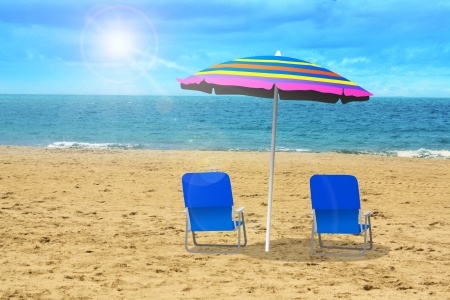 Summer is just far too short! It is that rare time when we Alaskans get to slather on the sunscreen and bug repellent and … hold the presses! Sunscreen and bug repellent?! Sure, I understand the evening mosquito warfare problem; and getting some summer sunlight is pretty important, but isn’t there a better way?
Summer is just far too short! It is that rare time when we Alaskans get to slather on the sunscreen and bug repellent and … hold the presses! Sunscreen and bug repellent?! Sure, I understand the evening mosquito warfare problem; and getting some summer sunlight is pretty important, but isn’t there a better way?
Before it’s too late, let’s take apart the Vitamin D, sunlight and bug spray myths once and for all:
Myth #1. Sun exposure is bad for you. Truth #1: Direct sunshine is healthy. Although overdoing it and burning your skin is most definitely a bad idea and linked with various forms of cancer.
Unless you burn yourself, sun exposure actually decreases the risk of melanoma, boosts mood and also helps your immune system. Safe sun exposure is the key so you will really want to understand a few key things.
What is “safe sun exposure”?
 Sunlight comes in a rainbow of colors. The rainbow we see is just one part of it; there is a full spectrum of energy at wavelengths we cannot see: heat (infra-red), radio waves, microwaves, ultraviolet… some of these are very helpful while others should be avoided—but how to de-select the ones you don’t want to hit your skin? Sunlight is all of them.
Sunlight comes in a rainbow of colors. The rainbow we see is just one part of it; there is a full spectrum of energy at wavelengths we cannot see: heat (infra-red), radio waves, microwaves, ultraviolet… some of these are very helpful while others should be avoided—but how to de-select the ones you don’t want to hit your skin? Sunlight is all of them.
Sunburn happens when the amount of ultraviolet (UV) exposure is more than what can be protected by the skin’s melanin. But before you get the idea that UV is bad, let me explain: there are several ranges of UV light, each has different effects on health. Advertising folks promoting tanning beds and other wares have created a big confusion.
Get UV-A not UV-B? or is it UV-B not UV-A? Yikes! that’s confusing…
Let’s look at UV-A and UV-B (the third and most harmful, UV-C, is almost entirely filtered out by the atmosphere).
Tanning bed operators have marketed UV-A as the “good guy”—tanning beds mostly emit UV-A. Yet a certain prominent health professional’s newsletter calls UV-B the “good guy” and sells a UV-A blocking sunscreen. And yet another whole array of skin products block only the “bad” UV-B and recently some have been developed to also block “harmful” UV-A. Help!
Truthfully, it is incorrect to label either form “good” or “bad.” UV-B is “good” in that it is the only sunlight that helps your skin produce vitamin D—a key nutrient hormone that helps your immune system, promotes wound healing, helps cells absorb calcium, is important for bone health, and can dramatically influence mood and behavior. Importantly, UV-B can also be the “bad guy”. Too much UV-B is the main cause of sunburn, damages skin and causes it to look aged, and is linked with skin cancer.
But calling UV-A the “good guy” is misguided. Although promoted by tanning bed operators, UV-A isn’t exactly safe either. Unlike shorter-wave UV-B rays, UV-A rays go through clouds, right through glass, and penetrate into the deeper layers of your skin. UV-A causes wrinkles by breaking down the skin’s elastin and collagen. It can cause cancer directly while also exacerbating the cancer-causing effects of UV-B. And just like UV-B, too much absorption of UV-A can produce sunburn. The one thing UV-A doesn’t do; it doesn’t help the body make vitamin D.
In fact, it may be backwards (from a health standpoint) to go out in the sun only in the early morning or late afternoon because vitamin D-producing UV-B is only found in high angle sunlight (noon, summer sun)—and quickly decreases with lower angles of sunlight. UV-A is always there, always penetrating.
Sunlight and vitamin D
For a goodly number of reasons, most people today have insufficient vitamin D levels. Cells in 36 organs respond biologically to vitamin D. In addition to its contribution to bone health, vitamin D seems to prevent some types of cancer and protect against multiple sclerosis and rheumatoid arthritis. A researcher at the University of California, Riverside, notes that “D” affects insulin secretion and regulation, heart and blood pressure regulation, muscle strength and brain activity.
Think about vitamin D deficiency any time there is chronic inflammation: heart disease, hypertension, autoimmune diseases, certain cancers, depression, chronic fatigue, or chronic pain. Think about it also if there are signs of osteoporosis or low bone density because vitamin D is required to absorb and transport dietary calcium.
But synthetic vitamin D capsules are not the answer. They are not the whole vitamin nor do they contain the minerals and other factors needed for the vitamin to work.
So, back to sunlight… Get out in it.
Take a 15-20 minute break at noon and luxuriate in direct, high, sunlight. Boost your vitamin D, breath the fresh air, get a little exercise. Check out this article on cholesterol (myths) and enjoy that high-vitamin D butter and other fats your body truly needs.
Myth #2: You should always wear sunscreen. Truth #2: Sunscreen contains some of the most powerful free radical generators known to man: dioxybenzone, oxybenzone and para aminobenzoic acid (PABA).
 A note to parents … You are undoubtedly very conscientious about caring for your children. I know you’ve been told to carefully protect your children from the sun’s harmful rays by lathering on the sunscreen. Please read the list of toxic chemicals on the bottle; you could in fact be doing more harm than good. In fact, chemicals in sunscreen penetrate the skin quite deeply and its toxic chemicals can rapidly be detected in the bloodstream.
A note to parents … You are undoubtedly very conscientious about caring for your children. I know you’ve been told to carefully protect your children from the sun’s harmful rays by lathering on the sunscreen. Please read the list of toxic chemicals on the bottle; you could in fact be doing more harm than good. In fact, chemicals in sunscreen penetrate the skin quite deeply and its toxic chemicals can rapidly be detected in the bloodstream.
Most sunscreens block UV-B (some also block UV-A) and prevent the beneficial effects of making vitamin D. The best way to protect your skin is by short exposure and covering up when the exposure is long enough to begin a burn.
Check out what this doctor has to say about safe and natural, and healthful, coconut oil:
Truth #3: Sunscreen and DEET create a potent mix
Recent toxicology studies show that mixing sunscreen with bug repellent cause the toxic chemicals in the bug juice to more deeply penetrate the skin. Standard 20% DEET takes about 30 minutes to penetrate, but 10% DEET plus sunscreen was detectable deep in the skin and bloodstream in as little as 5 minutes, even though it contained half as much DEET. Children’s bug juice (usually about 4% DEET or sometimes pyrethrin) was also detected in the bloodstream when combined with sunscreen.
DEET sprays can melt plastic bags and fishing lines. Does that make you wonder what it can do to you? It should, pesticides are one of the suspect toxics named in Persian Gulf War Syndrome and other neurologic diseases. DEET and pyrethrin kill insects by destroying their nervous system.
Are there any effective and natural mosquito repellents?
Well, yes—interestingly, boosting your immune system is repulsive to bugs. No kidding. People with more healthy immune systems tend to suffer fewer bug-bites. So that is great news for all of you who are using a healthful whole foods diet. Bananas attract insects; B complex vitamins (think green vegetables) seem to repel them.
And more good news: the most effective natural mosquito repellent is far more effective than DEET. The envelope please… according to a study in the New England Journal of Medicine, Repel Lemon Eucalyptus provided 120.1 minutes of mosquito protection—a whopping half hour longer protection than Off Skintastic for Kids at 88.4 minutes. Not only that, but Bite Blocker, a combination of Geranium oil and soybean oil, provided 94.6 minutes of protection.
In fact, most natural bug repellents use essential oils from these herbs:
- Catnip
- Cedarwood
- Cinnamon
- Citronella
- Clove
- Eucalyptus
- Geranium
- Lavender
- Lemongrass
- Patchouli
- Peppermint
- Rosemary
- Tea Tree
Important Note: Some citrus oils, like lemon, also have strong bug repellent properties, but are also considered “phototoxic”, meaning that the skin could damage or burn easily if those oils are applied to the skin and then exposed to any source of ultraviolet (UV) light.
So, enjoy your fun in the sun, just keep it short and then put a shirt on. Get your vitamin D and keep your immune system healthy while at the same time avoiding the flying warfare. Save money by making your own blend of coconut oil and herb sunscreen / bug spray.
And please send a comment if you find a particularly useful blend. Enjoy our beautiful summer!!
[contact-form-7 id=”1851″ title=”Question form blog page”]








I like the helpful whole foods health information you provide in your articles.
I’ll bookmark your blog and check back regularly.
I’m certain I’ll be informed lots and look forward to new stuff! Best of luck for the next!